英语单词变复数
- 格式:doc
- 大小:32.00 KB
- 文档页数:2
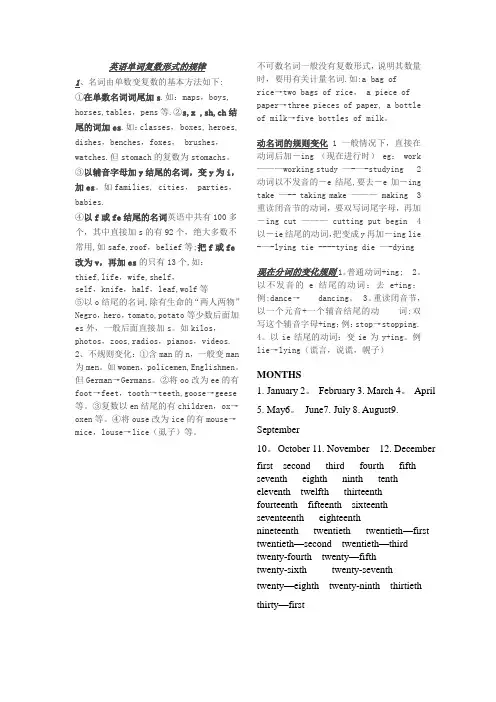
英语单词复数形式的规律1、名词由单数变复数的基本方法如下:①在单数名词词尾加s.如:maps,boys, horses,tables,pens等.②s,x ,sh,ch结尾的词加es.如:classes, boxes, heroes, dishes,benches,foxes, brushes,watches.但stomach的复数为stomachs。
③以辅音字母加y结尾的名词,变y为i,加es。
如families, cities, parties,babies.④以f或fe结尾的名词英语中共有100多个,其中直接加s的有92个,绝大多数不常用,如safe,roof,belief等;把f或fe 改为v,再加es的只有13个,如:thief,life,wife,shelf,self,knife,half,leaf,wolf等⑤以o结尾的名词,除有生命的“两人两物”Negro,hero,tomato,potato等少数后面加es外,一般后面直接加s。
如kilos,photos,zoos,radios,pianos,videos.2、不规则变化:①含man的n,一般变man 为men。
如women,policemen,Englishmen。
但German→Germans。
②将oo改为ee的有foot→feet,tooth→teeth,goose→geese 等。
③复数以en结尾的有children,ox→oxen等。
④将ouse改为ice的有mouse→mice,louse→lice(虱子)等。
不可数名词一般没有复数形式,说明其数量时,要用有关计量名词.如:a bag ofrice→two bags of rice, a piece of paper→three pieces of paper, a bottleof milk→five bottles of milk。
动名词的规则变化 1 一般情况下,直接在动词后加-ing (现在进行时) eg: work ———working study —-—-studying 2动词以不发音的-e结尾,要去-e加-ing take —-- taking make ——— making 3重读闭音节的动词,要双写词尾字母,再加-ing cut ——— cutting put begin 4以-ie结尾的动词,把变成y再加-ing lie -—-lying tie ----tying die —-dying现在分词的变化规则1。
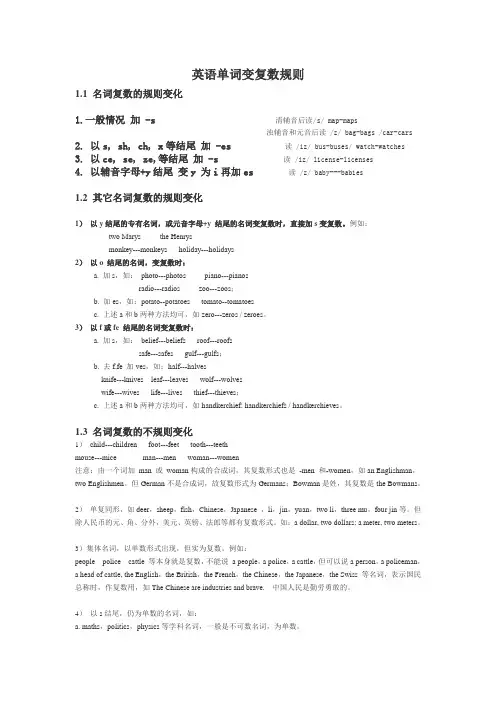
英语单词变复数规则1.1 名词复数的规则变化1.一般情况加 -s清辅音后读/s/ map-maps浊辅音和元音后读 /z/ bag-bags /car-cars2. 以s, sh, ch, x等结尾加 -es 读 /iz/ bus-buses/ watch-watches3. 以ce, se, ze,等结尾加 -s 读 /iz/ license-licenses4. 以辅音字母+y结尾变y 为i再加es 读 /z/ baby---babies1.2 其它名词复数的规则变化1)以y结尾的专有名词,或元音字母+y 结尾的名词变复数时,直接加s变复数。
例如:two Marys the Henrysmonkey---monkeys holiday---holidays2)以o 结尾的名词,变复数时:a. 加s,如:photo---photos piano---pianosradio---radios zoo---zoos;b. 加es,如:potato--potatoes tomato--tomatoesc. 上述a和b两种方法均可,如zero---zeros / zeroes。
3)以f或fe 结尾的名词变复数时:a. 加s,如:belief---beliefs roof---roofssafe---safes gulf---gulfs;b. 去f,fe 加ves,如:half---halvesknife---knives leaf---leaves wolf---wolveswife---wives life---lives thief---thieves;c. 上述a和b两种方法均可,如handkerchief: handkerchiefs / handkerchieves。
1.3 名词复数的不规则变化1)child---children foot---feet tooth---teethmouse---mice man---men woman---women注意:由一个词加man 或woman构成的合成词,其复数形式也是-men 和-women,如an Englishman,two Englishmen。

单词单数变复数规则1)单数名词加s: students, apples, bags, trees, books, brothers.2)以s、x、sh、ch结尾的名词加es: glasses, boxes, brushes, matches.3)以辅音字母加y结尾的名词,变y为i加es: cities, babies, enemies.4)以f或fe结尾的名词,多数变f为v加es: wives, knives.但有些词只加s: roofs, proof s, chiefs.5)以o结尾的名词,有些加es: Negroes, heroes, tomatoes, potatoes.其它加s: radio s, zoos, pianos, photos.6)不规则名词:foot→feet, goose→geese, tooth→teeth, child→children, man→me n, woman→women, sheep→sheep, deer→deer, mouse→mice.7)某些外来词变复数:datum→data, medium→media, bacterium→bacteria, curriculum→curricula, criterion→criteria, phenomenon→phenomena. (um/on→a)analysis→analyses, basis→bases, crisis→crises, diagnosis→diagnoses.(is→es )8)复合名词变复数:以不可数名词结尾的复合名词无复数形式,如:homework.以man或woman为前缀的复合名词变复数,前后两个名词都变复数,如:manservant→menservants, woman student women students.其它复合名词变复数:grown up→grown ups, brother in law→brothers in law, stand by→stands by.9)复合形容词做定语时,其中的名词保持单数:a six-year old boy,a two hundred page book。
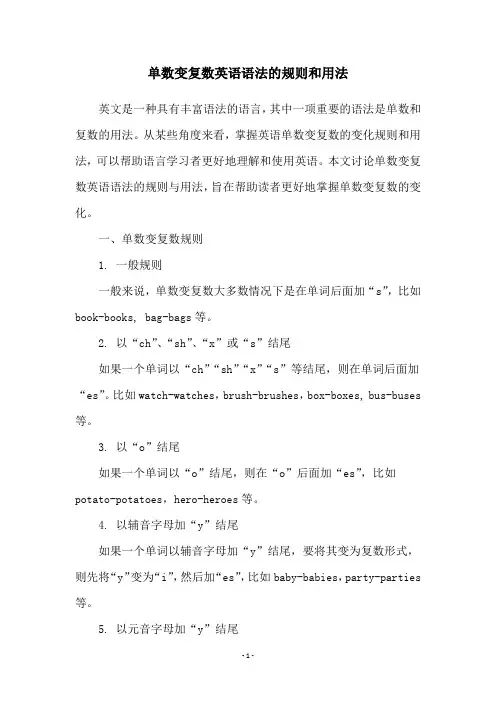
单数变复数英语语法的规则和用法英文是一种具有丰富语法的语言,其中一项重要的语法是单数和复数的用法。
从某些角度来看,掌握英语单数变复数的变化规则和用法,可以帮助语言学习者更好地理解和使用英语。
本文讨论单数变复数英语语法的规则与用法,旨在帮助读者更好地掌握单数变复数的变化。
一、单数变复数规则1. 一般规则一般来说,单数变复数大多数情况下是在单词后面加“s”,比如book-books, bag-bags等。
2. 以“ch”、“sh”、“x”或“s”结尾如果一个单词以“ch”“sh”“x”“s”等结尾,则在单词后面加“es”。
比如watch-watches,brush-brushes,box-boxes, bus-buses 等。
3. 以“o”结尾如果一个单词以“o”结尾,则在“o”后面加“es”,比如potato-potatoes,hero-heroes等。
4. 以辅音字母加“y”结尾如果一个单词以辅音字母加“y”结尾,要将其变为复数形式,则先将“y”变为“i”,然后加“es”,比如baby-babies,party-parties 等。
5. 以元音字母加“y”结尾如果一个单词以元音字母加“y”结尾,则直接在单词后面加“s”,比如day-days,boy-boys等。
6. 以“f”或“fe”结尾如果一个单词以“f”或“fe”结尾,则将“f”或“fe”变为“ves”,比如knife-knives,wife-wives等。
7.写末尾字母有些单词变复数时要重复末尾字母,比如shop-shops,wish-wishes等。
二、变复数用法1.词单数,主语和宾语用复数在英语中,名词只用单数形式,而主语和宾语则要用复数形式。
例如:The cat (主语名词) is playing.She loves cats (宾语名词).2.词和形容词用复数如果主语前面有用于修饰名词的数词或形容词,则名词也要用复数形式。
例如:The two cats (主语名词) are playing.His beautiful cats (宾语名词) are sleeping.3.数词和形容词外,其他词用单数除了数词和形容词外,其他词在主语和宾语前不能用复数形式,应当用单数形式。
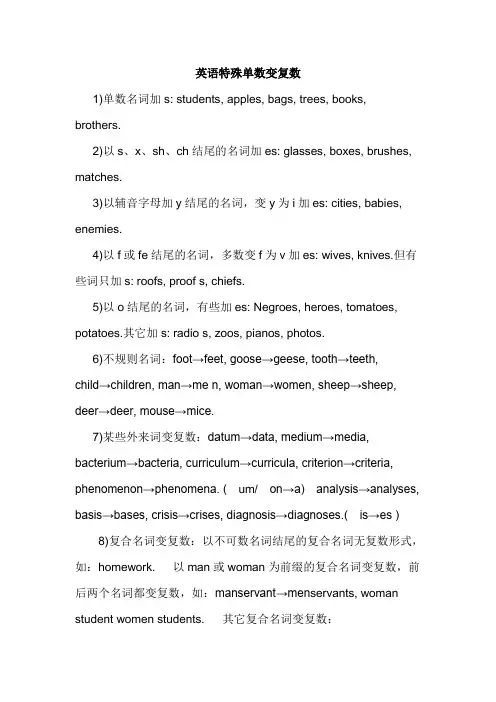
英语特殊单数变复数1)单数名词加s: students, apples, bags, trees, books, brothers.2)以s、x、sh、ch结尾的名词加es: glasses, boxes, brushes, matches.3)以辅音字母加y结尾的名词,变y为i加es: cities, babies, enemies.4)以f或fe结尾的名词,多数变f为v加es: wives, knives.但有些词只加s: roofs, proof s, chiefs.5)以o结尾的名词,有些加es: Negroes, heroes, tomatoes, potatoes.其它加s: radio s, zoos, pianos, photos.6)不规则名词:foot→feet, goose→geese, tooth→teeth,child→children, man→me n, woman→women, sheep→sheep, deer→deer, mouse→mice.7)某些外来词变复数:datum→data, medium→media, bacterium→bacteria, curriculum→curricula, criterion→criteria, phenomenon→phenomena. ( um/ on→a) analysis→analyses, basis→bases, crisis→crises, diagnosis→diagnoses.( is→es )8)复合名词变复数:以不可数名词结尾的复合名词无复数形式,如:homework. 以man或woman为前缀的复合名词变复数,前后两个名词都变复数,如:manservant→men servants, woman student women students. 其它复合名词变复数:grown up→grown ups, brother in law→brothers in law, stand by→stands by. 答案补充9)复合形容词做定语时,其中的名词保持单数:a six year old boy,a two hundred page book 名词复数:)~~ 英语中名词可分为可数名词和不可数名词。
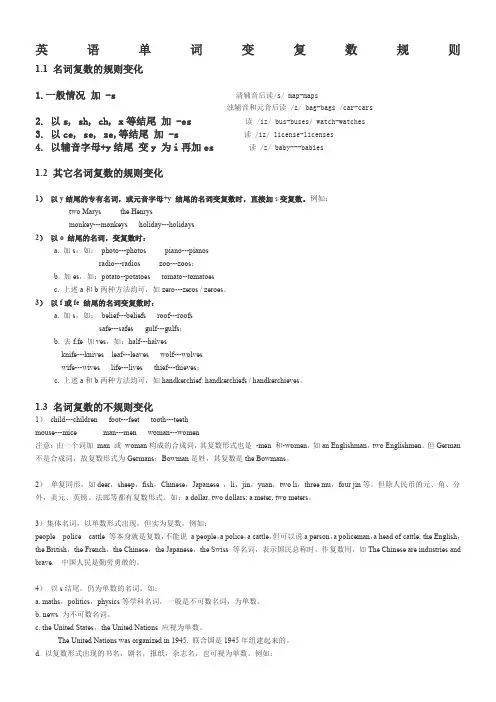
英语单词变复数规则1.1 名词复数的规则变化1.一般情况加 -s清辅音后读/s/ map-maps浊辅音和元音后读 /z/ bag-bags /car-cars2. 以s, sh, ch, x等结尾加 -es 读 /iz/ bus-buses/ watch-watches3. 以ce, se, ze,等结尾加 -s 读 /iz/ license-licenses4. 以辅音字母+y结尾变y 为i再加es 读 /z/ baby---babies1.2 其它名词复数的规则变化1)以y结尾的专有名词,或元音字母+y 结尾的名词变复数时,直接加s变复数。
例如:two Marys the Henrysmonkey---monkeys holiday---holidays2)以o 结尾的名词,变复数时:a. 加s,如:photo---photos piano---pianosradio---radios zoo---zoos;b. 加es,如:potato--potatoes tomato--tomatoesc. 上述a和b两种方法均可,如zero---zeros / zeroes。
3)以f或fe 结尾的名词变复数时:a. 加s,如:belief---beliefs roof---roofssafe---safes gulf---gulfs;b. 去f,fe 加ves,如:half---halvesknife---knives leaf---leaves wolf---wolveswife---wives life---lives thief---thieves;c. 上述a和b两种方法均可,如handkerchief: handkerchiefs / handkerchieves。
1.3 名词复数的不规则变化1)child---children foot---feet tooth---teethmouse---mice man---men woman---women注意:由一个词加man 或woman构成的合成词,其复数形式也是-men 和-women,如an Englishman,two Englishmen。
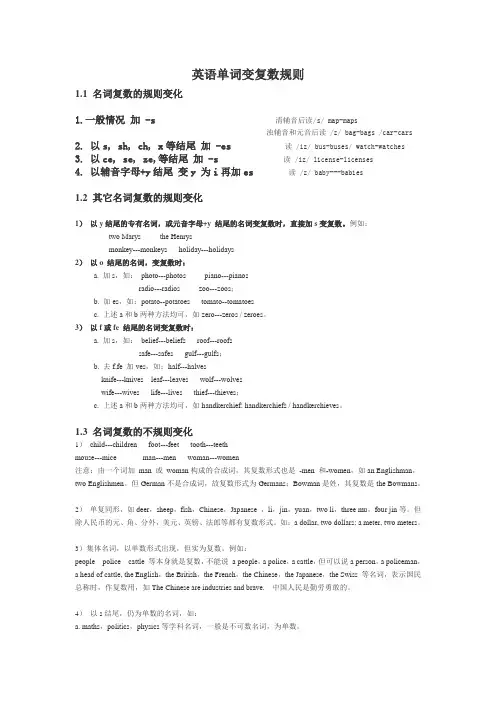
英语单词变复数规则1.1 名词复数的规则变化1.一般情况加 -s清辅音后读/s/ map-maps浊辅音和元音后读 /z/ bag-bags /car-cars2. 以s, sh, ch, x等结尾加 -es 读 /iz/ bus-buses/ watch-watches3. 以ce, se, ze,等结尾加 -s 读 /iz/ license-licenses4. 以辅音字母+y结尾变y 为i再加es 读 /z/ baby---babies1.2 其它名词复数的规则变化1)以y结尾的专有名词,或元音字母+y 结尾的名词变复数时,直接加s变复数。
例如:two Marys the Henrysmonkey---monkeys holiday---holidays2)以o 结尾的名词,变复数时:a. 加s,如:photo---photos piano---pianosradio---radios zoo---zoos;b. 加es,如:potato--potatoes tomato--tomatoesc. 上述a和b两种方法均可,如zero---zeros / zeroes。
3)以f或fe 结尾的名词变复数时:a. 加s,如:belief---beliefs roof---roofssafe---safes gulf---gulfs;b. 去f,fe 加ves,如:half---halvesknife---knives leaf---leaves wolf---wolveswife---wives life---lives thief---thieves;c. 上述a和b两种方法均可,如handkerchief: handkerchiefs / handkerchieves。
1.3 名词复数的不规则变化1)child---children foot---feet tooth---teethmouse---mice man---men woman---women注意:由一个词加man 或woman构成的合成词,其复数形式也是-men 和-women,如an Englishman,two Englishmen。
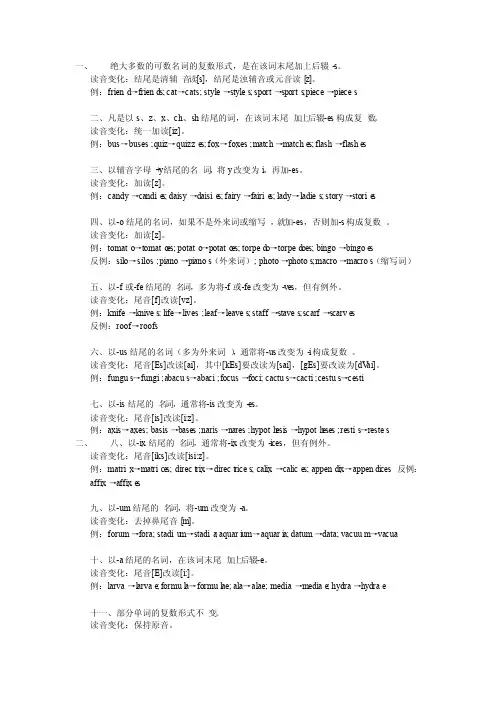
一、绝大多数的可数名词的复数形式,是在该词末尾加上后辍-s。
读音变化:结尾是清辅音读[s],结尾是浊辅音或元音读[z]。
例:friend→friend s; cat→cats; style→styles; sport→sports; piece→pieces二、凡是以s、z、x、ch、sh结尾的词,在该词末尾加上后辍-es构成复数。
读音变化:统一加读[iz]。
例:bus→buses; quiz→quizze s; fox→foxes; match→matche s; flash→flashe s三、以辅音字母+y结尾的名词,将y改变为i,再加-es。
读音变化:加读[z]。
例:candy→candie s; daisy→daisie s; fairy→fairie s; lady→ladies; story→storie s四、以-o结尾的名词,如果不是外来词或缩写,就加-es,否则加-s构成复数。
读音变化:加读[z]。
例:tomato→tomato es; potato→potato es; torped o→torped oes; bingo→bingoe s反例:silo→silos; piano→pianos(外来词); photo→photos; macro→macros(缩写词)五、以-f或-fe结尾的名词,多为将-f或-fe改变为-ves,但有例外。
读音变化:尾音[f]改读[vz]。
例:knife→knives; life→lives; leaf→leaves; staff→staves; scarf→scarve s反例:roof→roofs六、以-us结尾的名词(多为外来词),通常将-us改变为-i构成复数。
读音变化:尾音[Es]改读[ai],其中[kEs]要改读为[sai],[gEs]要改读为[dV ai]。
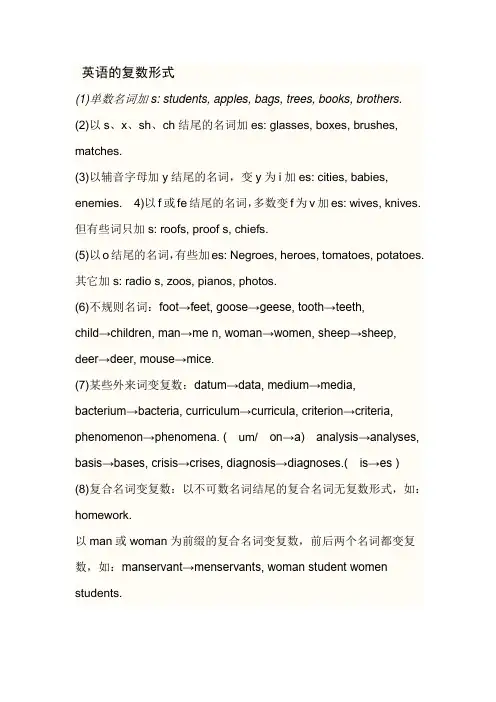
英语的复数形式(1)单数名词加s: students, apples, bags, trees, books, brothers.(2)以s、x、sh、ch结尾的名词加es: glasses, boxes, brushes, matches.(3)以辅音字母加y结尾的名词,变y为i加es: cities, babies, enemies.4)以f或fe结尾的名词,多数变f为v加es: wives, knives.但有些词只加s: roofs, proof s, chiefs.(5)以o结尾的名词,有些加es: Negroes, heroes, tomatoes, potatoes.其它加s: radio s, zoos, pianos, photos.(6)不规则名词:foot→feet, goose→geese, tooth→teeth,child→children, man→me n, woman→women, sheep→sheep,de er→deer, mouse→mice.(7)某些外来词变复数:datum→data, medium→media,bacterium→bacteria, curriculum→curricula, criterion→criteria, phenomenon→phenomena. (um/on→a)analysis→analyses, basis→bases, crisis→crises, diagnosis→diagnoses.(is→es ) (8)复合名词变复数:以不可数名词结尾的复合名词无复数形式,如:homework.以man或woman为前缀的复合名词变复数,前后两个名词都变复数,如:manservant→menservants, woman student women students.其它复合名词变复数:grown up→grown ups,brother in law→brothers in law, stand by→stands by. (9)复合形容词做定语时,其中的名词保持单数:a six year old boy,a two hundred page book。
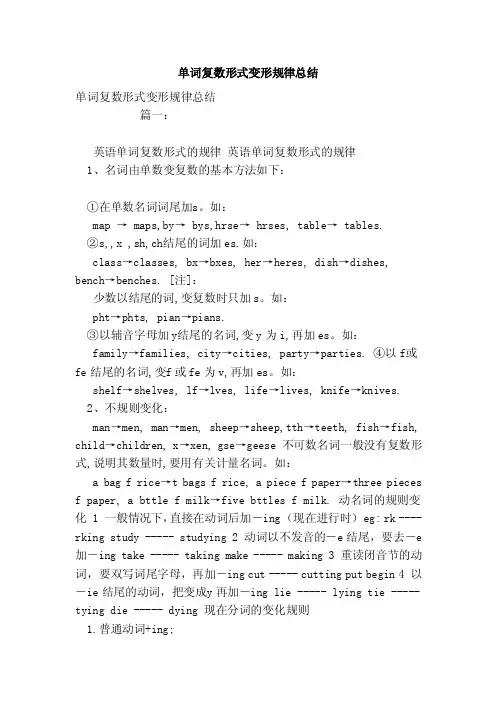
单词复数形式变形规律总结单词复数形式变形规律总结篇一:英语单词复数形式的规律英语单词复数形式的规律1、名词由单数变复数的基本方法如下:①在单数名词词尾加s。
如:map → maps,by→ bys,hrse→ hrses, t able→ tabl es.②s,,x ,sh,ch结尾的词加es.如:class→c lasses, bx→bxes, her→heres, di sh→dishes,bench→ben ches. [注]:少数以结尾的词,变复数时只加s。
如:pht→phts, pian→pians.③以辅音字母加y结尾的名词,变y为i,再加es。
如:family→fa milies, ci ty→cities, party→par ties. ④以f或fe结尾的名词,变f或fe为v,再加es。
如:she lf→shelves, lf→lves, life→live s, knife→k nives.2、不规则变化:man→men, man→men,sheep→shee p,tth→teet h, fish→fi sh, child→children,x→xen, gse→geese 不可数名词一般没有复数形式,说明其数量时,要用有关计量名词。
如:a bag f rice→t ba gs f rice, a piece f paper→thr ee piecesf paper, a bttle f m ilk→five b ttles f mi lk. 动名词的规则变化 1 一般情况下,直接在动词后加-i ng (现在进行时) eg: rk ---- rking s tudy ----- studying2 动词以不发音的-e结尾,要去-e 加-ing take ----- takin g make ----- making3 重读闭音节的动词,要双写词尾字母,再加-ing cut----- cutt ing put be gin 4 以-ie结尾的动词,把变成y再加-ing lie ----- lyi ng tie ----- tying d ie ----- d ying 现在分词的变化规则1.普通动词+ing;2.以不发音的e结尾的动词:去e+ing;例:dance→ dancing.3.重读闭音节,以一个元音+一个辅音结尾的动词:双写这个辅音字母+ing;例:stp→stppi ng.4.以ie结尾的动词:变ie为y+i ng.例lie→ly ing(谎言,说谎,幌子)篇二:英语单词复数形式大总结英语单词复数形式大总结表示名词复数,在中文方面显得很简单,如:一个苹果、五个苹果;一座桥、两座桥;一匹马、五十匹马……名词完全相同。
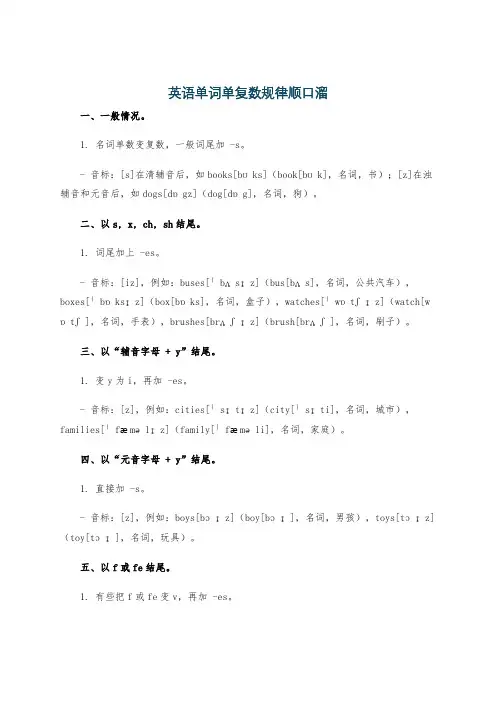
英语单词单复数规律顺口溜一、一般情况。
1. 名词单数变复数,一般词尾加 -s。
- 音标:[s]在清辅音后,如books[bʊks](book[bʊk],名词,书);[z]在浊辅音和元音后,如dogs[dɒgz](dog[dɒg],名词,狗)。
二、以s, x, ch, sh结尾。
1. 词尾加上 -es。
- 音标:[iz],例如:buses[ˈbʌsɪz](bus[bʌs],名词,公共汽车),boxes[ˈbɒksɪz](box[bɒks],名词,盒子),watches[ˈwɒtʃɪz](watch[w ɒtʃ],名词,手表),brushes[brʌʃɪz](brush[brʌʃ],名词,刷子)。
三、以“辅音字母 + y”结尾。
1. 变y为i,再加 -es。
- 音标:[z],例如:cities[ˈsɪtɪz](city[ˈsɪti],名词,城市),families[ˈfæməlɪz](family[ˈfæməli],名词,家庭)。
四、以“元音字母 + y”结尾。
1. 直接加 -s。
- 音标:[z],例如:boys[bɔɪz](boy[bɔɪ],名词,男孩),toys[tɔɪz](toy[tɔɪ],名词,玩具)。
五、以f或fe结尾。
1. 有些把f或fe变v,再加 -es。
- 音标:[vz],例如:leaves[liːvz](leaf[liːf],名词,树叶),knives[naɪvz](knife[naɪf],名词,刀)。
2. 但也有直接加 -s的,如roofs[ruːfs](roof[ruːf],名词,屋顶)。
六、特殊变化。
1. 单复数同形,如:fish[fɪʃ] - fish[fɪʃ](名词,鱼),deer[dɪə(r)] - deer[dɪə(r)](名词,鹿),sheep[ʃiːp] - sheep[ʃiːp](名词,绵羊)。
2. 不规则变化,如:man[mæn] - men[men](名词,男人),woman[ˈwʊmən] - women[ˈwɪmɪn](名词,女人),child[tʃaɪld] - children[ˈtʃɪldrən](名词,孩子),foot[fʊt] - feet[fiːt](名词,脚),tooth[tuːθ] -teeth[tiːθ](名词,牙齿)。
英语单词变复数规则1.1 名词复数的规则变化1.一般情况加 -s清辅音后读/s/ map-maps浊辅音和元音后读 /z/ bag-bags /car-cars2. 以s, sh, ch, x等结尾加 -es 读 /iz/ bus-buses/ watch-watches3. 以ce, se, ze,等结尾加 -s 读 /iz/ license-licenses4. 以辅音字母+y结尾变y 为i再加es 读 /z/ baby---babies1.2 其它名词复数的规则变化1)以y结尾的专有名词,或元音字母+y 结尾的名词变复数时,直接加s变复数。
例如: two Marys the Henrysmonkey---monkeys holiday---holidays2)以o 结尾的名词,变复数时:a. 加s,如: photo---photos piano---pianosradio---radios zoo---zoos;b. 加es,如:potato--potatoes tomato--tomatoesc. 上述a和b两种方法均可,如zero---zeros / zeroes。
3)以f或fe 结尾的名词变复数时:a. 加s,如: belief---beliefs roof---roofssafe---safes gulf---gulfs;b. 去f,fe 加ves,如:half---halvesknife---knives leaf---leaves wolf---wolveswife---wives life---lives thief---thieves;c. 上述a和b两种方法均可,如handkerchief: handkerchiefs / handkerchieves。
1.3 名词复数的不规则变化1) child---children foot---feet tooth---teethmouse---mice man---men woman---women注意:由一个词加 man 或 woman构成的合成词,其复数形式也是 -men 和-women,如an Englishman,two Englishmen。
英语语法:单词的复数形式一、英语单词复数形式的构成1. 一般情况下,英语单词复数形式是由单数形式加上后缀“-s”来构成的。
例如book→books, hand→hands。
2. 如果单词以s, x, ch, sh结尾,则加“-es”构成复数形式。
例如bus→buses, box→boxes,church→churches, shock→shocks。
3. 如果单词以辅音字母+y结尾,则将y改变为i+es。
例如family→families,strawberry→strawberries。
4. 如果单词以f或fe结尾,则将f或fe改变为v+es。
例如knife→knives, wife→wives。
5. 部分单词以o结尾时,有些要加-es,有些不加。
(1) 以元音字母+o结尾的单词,要加-es。
例如hero→heroes, potato→potatoes。
(2) 以辅音字母+o结尾的单词,一般不加-es。
例如tomato→tomatoes, volcano→volcanoes。
6. 部分单词有特殊的变化形式,而不是加后缀来构成复数形式。
(1) 以-f或-fe结尾的单词,通常会把-f或-fe变为-ves。
例如calf→calves, half→halves。
(2) 以-o结尾的单词,通常会把-o变为-oes。
例如echo→echoes, hero→heroes。
(3) 部分单词有特定的复数形式,如man→men, woman→women。
7. 部分复数形式表示特殊意义,如goods(物品)、clothes(衣服)、eyeglasses(眼镜)、scissors(剪刀)、jeans(牛仔裤)、trousers(裤子)等。
二、复数形式的分类1. 普通复数形式:有一般性的复数变化,如book→books, hand→hands等。
2. 不规则复数形式:有特殊的变化形式,如man→men, mouse→mice, foot→feet等。
英语单词复数形式的规律1、名词由单数变复数的基本方法如下:①在单数名词词尾加s。
如:map → maps,boy→ boys,horse→ horses, table→ tables.②s,o,x ,sh,ch结尾的词加es.如:class→classes, box→boxes, hero→heroes, dish→dishes, bench→benches.[注]:少数以o结尾的词,变复数时只加s。
如:photo→photos, piano→pianos.③以辅音字母加y结尾的名词,变y为i,再加es。
如:family→families,city→cities, party→parties.④以f或fe结尾的名词,变f或fe为v,再加es。
如:shelf→shelves, wolf→wolves, life→lives, knife→knives.2、不规则变化:man→men, woman→women, sheep→sheep,tooth→teeth, fish→fish, child→children, ox→oxen, goose→geese不可数名词一般没有复数形式,说明其数量时,要用有关计量名词。
如:a bag of rice→two bags of rice, a piece of paper→three pieces of paper, a bottle of milk→five bottles of milk.英语单词以f/fe结尾的名词变复数的口诀1、以-f(e)结尾的名词,在中学课本里,出现了不少。
其名词复数形式:有的直接在。
f(e)后加—s;有的要改—f(e)为ve再加-s;个别单词上述两种形式均可(如handkerchief→handkerchiefs或handkerchieves)。
似乎不易记住这些规则,可你只要记住下面这首顺口溜,相信你就不会觉得难了。
妻子(wife)持刀(knife)去宰狼(wolr),小偷(thief)吓得发了慌;躲在架后(shelf)保己命(myself),半(half)片树叶(leaf)遮目光。
T three piecesof paper, a bottle of milk T five bottles of milk.英语单词复数形式的规律1名词由单数变复数的基本方法如下:①在单数名词词尾力口s。
如:map~ maps,boy~ boys,horse 宀horses, table T tables.②s,o,x ,sh,ch 结尾的词力口es.女口:class T classes, box T boxes, hero T heroes, dish T dishes, bench T benches.[注]:少数以o结尾的词,变复数时只加s。
如:photo T photos,pia no T pia nos.③以辅音字母加y结尾的名词,变y为i,再加es。
如: f amily T families, city T cities, party T parties.④以f或fe结尾的名词,变f或fe为v,再加es。
女口:shelf T shelves, wolf T wolves, life T lives, knife T knives.2、不规贝U变化:mar r men, woma T women, sheep T sheep,tooth T teeth, fish T fish, child T children, ox T oxen, goose T geese不可数名词一般没有复数形式,说明其数量时,要用有关计量名词。
如:a bag of rice T two bags of rice, a piece of paper动名词的规则变化1 一般情况下,直接在动词后加—ing (现在进行时)eg: work ---- working study ——studying2 动词以不发音的一e结尾,要去一e加一ing take ——taki ng make —— mak ing3 重读闭音节的动词,要双写词尾字母,再加一ing cut —— cutting put begin 4 以一ie结尾的动词,把变成y再加—ing lie ---- lying tie ----- tying die ------ dyingdan ce —词:双写这个辅 为 y+ing.例 lie 现在分词的变化规则1.普通动词+ing;2.以不发音的e 结尾的动词:去e+ing;例: dancing.3.重读闭音节,以一个元音+—个辅音结尾的动 音字母+ing;例:stop — stopping.4. 以ie 结尾的动词:变ie Tying (谎言,说谎,幌子)。
英语单词复数形式的规律----263f3dba-6ebb-11ec-a4b5-
7cb59b590d7d
英语单词复数形式的规律1、名词由单数变复数的基本方法如下:
① 在单数名词后面加s。
例如:地图→ 地图,孩子→ 孩子们,马→ 马,桌子→ 桌子
②s,o,x,sh,ch结尾的词加es.如:
class→classes,box→boxes,hero→heroes,dish→dishes,bench→benches.
[注]:对于以O结尾的几个单词,当它们变成复数时,只添加s。
例如:照片→ 照片,钢琴→ 钢琴
③以辅音字母加y结尾的名词,变y为i,再加es。
如:
family→families,city→cities,party→parties.
④ 对于以f或Fe结尾的名词,将f或Fe改为V并加上es。
例如:shell→ 贝壳,
狼→ 狼,生命→ 生命,刀子→ 刀
2、不规则变化:man→men,woman→women,sheep→sheep,tooth→teeth,
鱼→鱼,孩子→孩子们,牛→牛,鹅→鹅
不可数名词一般没有复数形式,说明其数量时,要用有关计量名词。
如:
abagofrice→twobagsofrice,apieceofpaper→threepiecesofpaper,abottleofmilk→fiv ebottlesofmilk.。
学习必备欢迎下载英语单词复数形式的规律1、名词由单数变复数的基本方法如下:①在单数名词词尾加s。
如:maps,boys, horses,tables,pens等。
②s,x ,sh,ch结尾的词加es.如:classes, boxes, heroes, dishes,benches,foxes, brushes, watches。
但stomach的复数为stomachs。
③以辅音字母加y结尾的名词,变y为i,加es。
如families, cities, parties,babies。
④以f或fe结尾的名词英语中共有100多个,其中直接加s的有92个,绝大多数不常用,如safe,roof,belief等;把f或fe改为v,再加es的只有13个,如:thief,life,wife,shelf,self,knife,half,leaf,wolf等⑤以o结尾的名词,除有生命的“两人两物”Negro,hero,tomato,potato等少数后面加es外,一般后面直接加s.如kilos, photos,zoos,radios,pianos,videos.2、不规则变化:①含man的n,一般变man 为men.如women,policemen,Englishmen.但German→Germans.②将oo改为ee的有foot →feet,tooth→teeth,goose→geese等.③复数以en结尾的有children,ox→oxen等.④将ouse改为ice的有mouse→mice,louse →lice(虱子)等. 不可数名词一般没有复数形式,说明其数量时,要用有关计量名词。
如:a bag ofrice→two bags of rice, a piece ofpaper→three pieces of paper, a bottleof milk→five bottles of milk.动名词的规则变化 1 一般情况下,直接在动词后加-ing (现在进行时) eg: work---working study ----studying 2 动词以不发音的-e结尾,要去-e加-ing take--- taking make --- making 3 重读闭音节的动词,要双写词尾字母,再加-ing cut--- cutting put begin 4 以-ie结尾的动词,把变成y再加-ing lie ---lying tie----tying die --dying现在分词的变化规则1.普通动词+ing; 2.以不发音的e结尾的动词:去e+ing;例:dance→ dancing. 3.重读闭音节,以一个元音+一个辅音结尾的动词:双写这个辅音字母+ing;例:stop→stopping.4.以ie结尾的动词:变ie为y+ing.例lie→lying(谎言,说谎,幌子)MONTHS1. January2. February3. March4. April5. May6. June7. July8. August9. September 10. October 11. November 12. December first second third fourth fifth seventh eighth ninth tenth eleventh twelfth thirteenth fourteenth fifteenth sixteenth seventeenth eighteenthnineteenth twentieth twentieth-first twentieth-second twentieth-thirdtwenty-fourth twenty-fifth twenty-sixth twenty-seventhtwenty-eighth twenty-ninth thirtieth thirty-first。
一般情况加-s
1.清辅音后读/s/; map-maps
2.浊辅音和元音后bag-bags 读/z/; car-cars
以s,sh,ch, x等结尾的词加-es 读/iz/ bus-buses ,watch-watches
以ce,se,ze, (d)ge等结尾的词加-s 读/iz/ license-licenses
以辅音字母+y 变y 为i 结尾的词再加es 读/z/ baby---babies
名词复数的不规则变化
1)child---children foot---feet tooth---teeth
mouse---mice man---men woman---women
注意:与man 和woman构成的合成词,其复数形式也是-men 和-women。
如:an Englishman,two Englishmen. 但German不是合成词,故复数形式为Germans;Bowman是姓,其复数是the Bowmans。
2)单复同形如:
deer,sheep,fish,Chinese,Japanese
li,jin,yuan,two li,three mu,four jin
但除人民币元、角、分外,美元、英镑、法郎等都有复数形式。
如:
a dollar, two dollars; a meter, two meters
3)集体名词,以单数形式出现,但实为复数。
如:people police cattle 等本身就是复数,不能说a people,a police,a cattle,但可以说a person,a policeman,a head of cattle,the English,the British,the French,the Chinese,the Japanese,the Swiss 等名词,表示国民总称时,作复数用。
如:The Chinese are industries and brave. 中国人民是勤劳勇敢的。
4)以s结尾,仍为单数的名词,如:a. maths,politics,physics等学科名词,为不可数名词,是单数。
b. news 是不可数名词。
c. the United States,the United Nations 应视为单数。
The United Nations was organized in 1945. 联合国是1945年组建起来的。
d. 以复数形式出现的书名,剧名,报纸,杂志名,也可视为单数。
"The Arabian Nights" is a very interesting story-book.
<<一千零一夜>>是一本非常有趣的故事书。
5) 表示由两部分构成的东西,如:glasses (眼镜) trousers, clothes
若表达具体数目,要借助数量词pair(对,双); suit(套); a pair of glasses; two pairs of trousers
6)另外还有一些名词,其复数形式有时可表示特别意思,如:goods货物,waters 水域,fishes(各种)鱼
曾文:Miss Huang, 上七年级以来,我们学了不少复数名词,它们的变化规则我们都很熟悉了,可它们的读音有规律吗?
Miss Huang: 当然有。
哦,我这里正好有个可数名词复数形式的课件。
请先看展示:
1. lamps, cakes, months
2. animals, flags, planes; bananas, brothers, eyes, knees, radios
3. aunts, dates; cards, friends
4. boxes, glasses, oranges
5. leaf -leaves, wife - wives
李诗慧:哦,看得出来,第1组中的s都发/s/,第2组发/z/,第3组/ts/或/dz/,第4组/Iz/,第5组/vz/。
Miss Huang: 下面我来总结一下:以清辅音结尾的单数可数名词变复数名词后,词尾所加的-s读/s/;若单数名词以浊辅音或元音结尾,那词尾所加的-s,-es就读/z/;如果单数名词是以/t/或/d/结尾,变复数名词在词尾加-s或-es之后,就要与/t/、/d/一起读作/ts/或/dz/;若单数名词词尾是以/s/, /z/, //, /t/, /d/这五个辅音音素结尾,变复数后所加的-s,-es就读/Ιz/;我们知道,以-f或-fe结尾的单数名词变为复数名词时,常将-f或-fe变为-ves,其中的-ves 就读/vz/。
霍远强: 可是,这些都是规则变化的复数名词的读音规律,如果是不规则的该怎么办呢?
Miss Huang: 嗯,也有办法!到目前为止,我们所学的不规则复数名词还不多,比如:man /mn/ - men /men/, woman /`wumn/ - women /`wΙmΙn/, child /taΙld/ - children /`tΙldrn/, foot /fut/ - feet /fi:t/, 大家要注意哟。
哦,还有5个单、复数同形的也需记住:Chinese /`taΙ`ni:z/, Japanese /`dp`ni:z/ , fish /fΙ/, sheep /i:p/, deer /dΙ/ (鹿)。
这期先说到这吧,要用心记住啊。